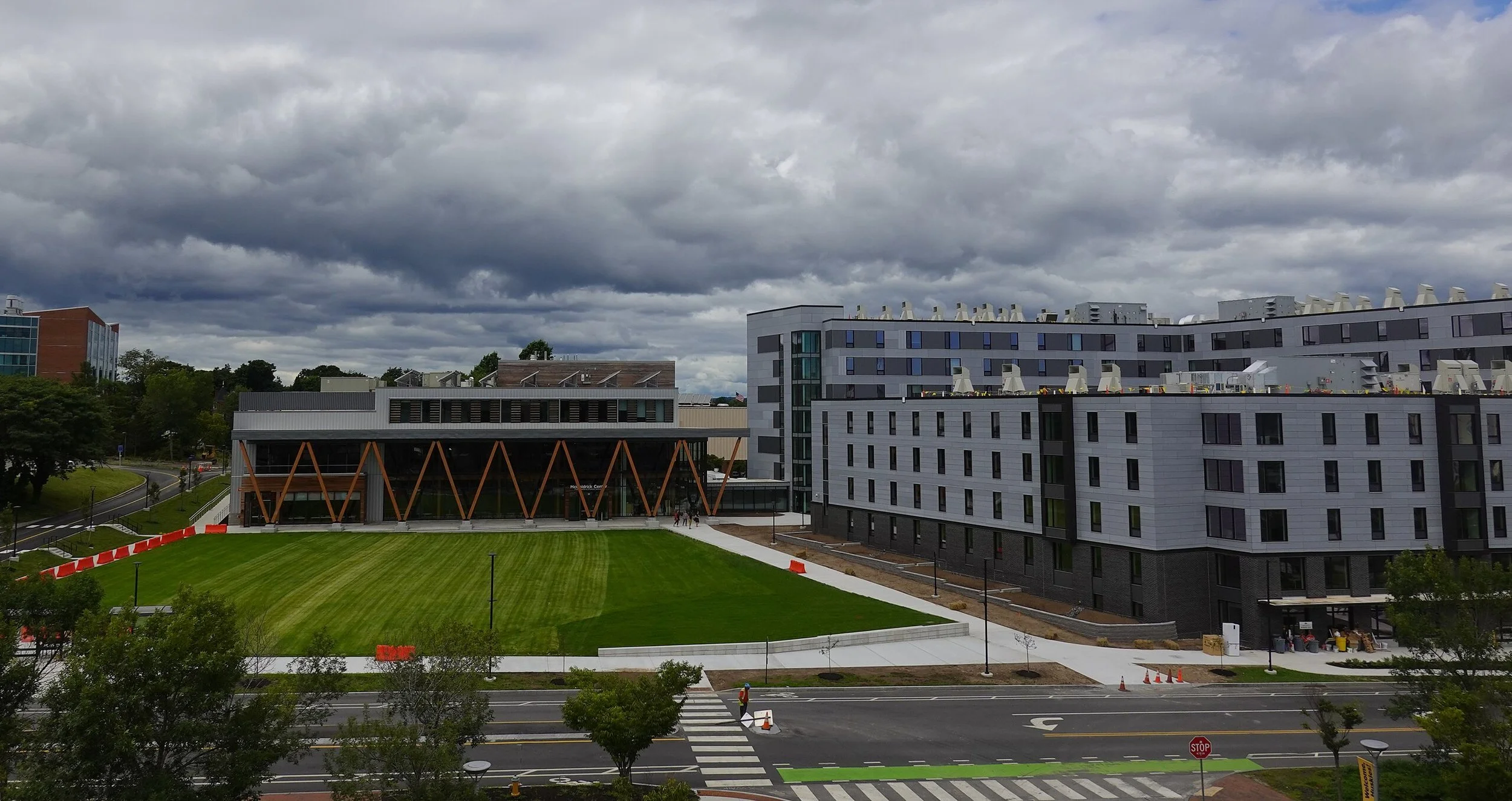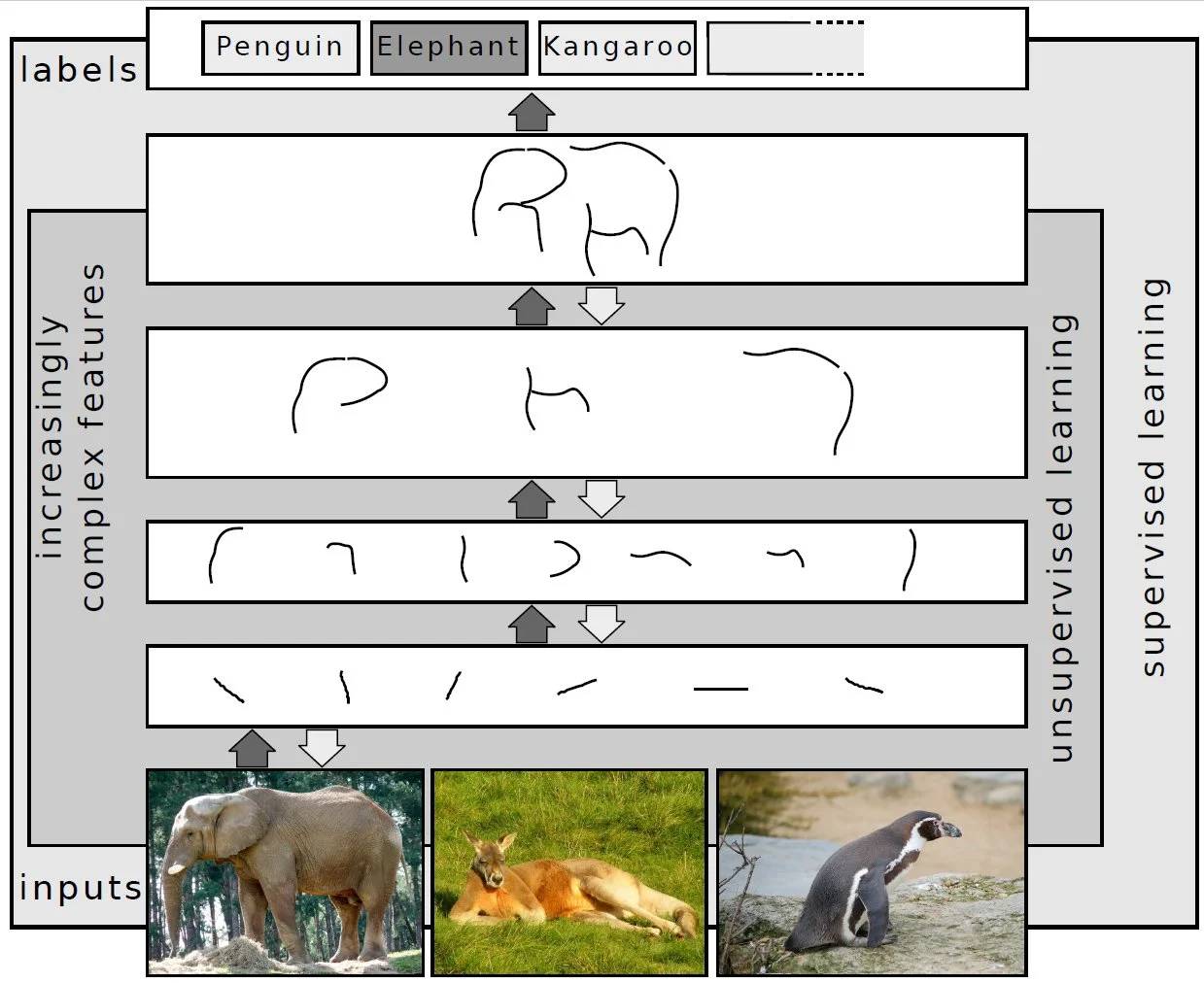
At the University of Southern Maine, ethics training in artificial intelligence
The McGoldrick Center for Career & Student Services, left, the Bean Green, and the Portland Commons dorm at the University of Southern Maine’s Portland campus.
— Photo by Metrodogmedia
AI at work: Representing images on multiple layers of abstraction in deep learning.
— Photo by Sven Behnke
Edited from a New England Council report:
“The University of Southern Maine (USM) “has received a $400,000 grant from the National Science Foundation to develop a training program for ethical-research practices in the age of artificial intelligence.
“With the growing prevalence of AI, especially such chatbots as Chat-GPT, experts have warned of the potential risks posed to integrity in research and technology development. Because research is an inherently stressful endeavor, often with time constraints and certain desired results, it can be tempting for researchers to cut corners, leaning on artificial intelligence to imitate the work of humans.
“At USM’s Regulatory Training and Ethics Center, faculty are studying what conditions lead to potential ethical misconduct and creating training sessions to make researchers conscious of their decisions and thoughts during their work and remain aware of stressors that might lead to mistakes in judgment. Faculty at USM believe this method will allow subjects to proactively avoid turning to unethical AI assistance.
“‘We hope to create a level of self-awareness so that when people are on the brink of taking a shortcut they will have the ability to reflect on that,’ said Bruce Thompson, a professor of psychology and principal at the USM ethics center. ‘It’s a preemptive way to interrupt the tendency to cheat or plagiarize.’’’
John O. Harney: New England vs. demographics
BOSTON
“The Great Recession and not-so-great recovery applies to all of us.”
That was University of Southern Maine professor Charlie Colgan’s remark at at the New England Economic Partnership (NEEP) conference Oct. 13 as he noted that Maine was just two-thirds of the way back to pre-recession employment levels.
The New England forecasts at the Fall Economic Outlook conference were generally cautiously optimistic, sprinkled with the expressed and implied NEEP mantra: “Having said that, I could be wrong.”
It may be the dismal science, but it’s an experiment you're part of every time you go to work or buy anything.
“What is relatively unique in New England is the region’s demographics—with a rapidly aging population and steep declines in young adult population threatening the region’s workforce skills and education advantage,” said New England Forecast Manager Ross Gittell, chancellor of the Community College System of New Hampshire.
In Maine, for example, Baby Boomers and their children simply had fewer babies, so all of Maine’s added population in the next 40 years will come from in-migration, but the big sources of that in-migration—Vermont and New Hampshire—are also shrinking, said Colgan. Will productivity increase enough to keep Maine and New England competitive?
Gittell and others joked that given the demography, the region should have focused on under-18 housing instead of over-65 housing.
Colgan noted that ship and boatbuilding have returned to Maine as a major industry (thanks to more destroyers being built at Bath Iron Works) and natural-resource industries have returned, in a sense, with Lincoln Logs coming back to Maine from China.
Colgan, by the way, is one of the professors let go recently by the University of Southern Maine—part of a higher-education disinvestment story that may say more about the future of the New England economy than any other layoff tracked by NEEP.
He warned that people in Maine see the loss of old-economy jobs such as the impending closure of the Verso paper mill in Bucksport as a tragedy, while they view the laying off of intellectuals at USM, who may be “from away” (though Colgan’s not) as a win for taxpayers.
Among tidbits from the other NEEP forecast managers:
Fairfield University professor emeritus Edward Deak noted that just 60 percent of Connecticut jobs lost during the recession have been regained in the Land of Steady Habits. No one knows whether they are as good as the jobs they’re replacing. What is clear in Connecticut, said Deak, is that “the well-to-do are doing very well.”
Connecticut has the sixth-oldest population in the U.S., though many people over age 65 are leaving the state after retiring. In retail, more purchases are being made via the Internet by working women with young children; fewer at the malls, Deak said, adding that when you look at Connecticut skylines, you don’t see any cranes. It’s all work on old buildings.
Bryant University assistant professor Edinaldo Tebaldi seemed relieved that Rhode Island is no longer first in unemployment; now it’s third. But this “gain” is associated with shrinking of the labor force, and the number of jobs is still below pre-recession levels.
New Hampshire has gone the other direction. Center for Public Policy Studies economist Dennis Delay said New Hampshire had been outperforming New England and U.S. job growth especially in early '80s, but is no longer the superstar. He showed 2012 migrants by higher educational attainments: lots of graduate or professional degrees among the foreign-born, but also many without a high school diploma. Delay noted that New Hampshire ranks high in indicators of home ownership, voter turnout and low welfare costs, but also high in student debt and low in growth of people ages 25-44—so-called wealth-building years.
Vermont economist Jeff Carr noted that about 90 percent of jobs there lost during the recession had been recovered—second in New England to Massachusetts, which has fully recovered jobs. Vermont is difficult to analyze because the job totals in each sector are small. But that small size adds to anxiety about the loss of a few-hundred highly paid jobs at the closing Vermont Yankee nuke; as well as perpetual concern about IBM because its decisions are made in Armonk, N.Y. Carr also cited the importance of Vermont’s food industry, including craft brewers. (The same day, the Vermont Foodbank reported that one-quarter of Vermont's citizens don't know where their next meal is coming from.)
Carr joked that he is in favor of financial-services bonuses in New York City and Boston because they boost Vermont's sizable second-home economy.
According to the New England regional forecast, prepared by Gittell, the regional economy will continue to see growth rates below the national average. The NEEP forecast is that total employment growth will average 1.3 percent a year—and all the New England states are projected to have employment growth below the national average over the forecast period out to 2018.
Mark Zandi, chief economist at Moody’s Analytics, opened the conference with a presentation on the U.S. Economic Outlook. In a year or so, growth in gross regional product could go from 3% to 4 percent fueled partly by more housing, including pent-up demand among millennials who have been renting. The economist, and increasingly visible TV pundit, contended that financial aspects of economy are in great shape, especially high-income households. Middle-incomes households are still encumbered by debt, he said, but the high end does most of the spending, “though I’m not arguing economy can flourish without everyone participating,” said Zandi.
Phew. He told of his son majoring in philosophy. (Reminded me of the founder of one of the nation’s leading career-oriented online providers confiding that his child was majoring in sociology on a traditional campus.)
Despite Zandi’s general optimism, the risks include interest rates and a mélange of global issues, Zandi noted, adding that even Ebola could undermine traveling and spending (may not be rational to be so concerned about it, but people are). In response to a question, Zandi said he doesn’t think income and wealth inequality is a big issue in a given year, compared with the lack of labor. No one’s going to be writing a book about income inequality soon, he said. Really?
In his keynote address, former Maine Gov. John E. Baldacci, now at the law firm of Pierce Atwood, cited the importance of energy and exports in the region’s economic future. He hailed natural gas as the foundation fuel, while the region works toward renewables, including solar, tidal and wood.
He tied exports to tourism, noting that the owner of New Balance sneakers was introduced to Maine via ski vacations, where he was treated well, then announced plans to open plants in the state.
In a concluding panel, William Guenther, chair and CEO of Mass Insight, boasted: “Massachusetts has benefited for years from the talent cluster that we have offered business.” He noted, however, that technology-focused jobs are growing in such areas as big data analytics, cybersecurity, and computer sciences, but the state is not producing enough college graduates with degrees in science, technology, engineering or math (STEM) to keep up with demand from business. "Jobs will always come to where the talent is,” said Guenther.
Jobs also go where there’s energy work. The state and Canadian province with the most explosive job sectors are oil- and gas-rich North Dakota and Alberta.
John O. Harney is executive editor of The New England Journal of Higher Education, the online publication of the New England Board of Higher Education (nebhe.org), where this column originated.


